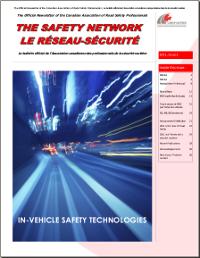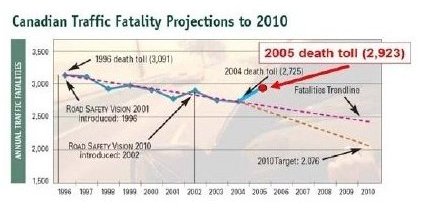Editorial - The Safety Network
The nature and magnitude of the road safety problem in Canada has seen dramatic changes over the past four decades. In particular, there has been a significant decline in fatalities associated with motor-vehicle collisions. Traffic fatalities peaked in 1973 when a total of 6,706 individuals were killed in road-related collisions. Since this peak, there has been a steady decline in the number of such deaths. By 2008, the most recent year for which data are available, the Canadian
fatality total was 2,419, representing a total reduction of 64% relative to the peak 1973 value. While this decline has resulted from a number of different factors, including the reduction in vehicle travel in recessionary times, the Canadian road safety community can take credit for the success of many important safety initiatives.
Canadian Traffic Fatalities: 1970-2008
While these statistics nominally provide a rosy view of road and motor vehicle safety in Canada, we must not lose sight of the fact that there are still many more than 2,000 people killed in crashes on an annual basis. Clearly, there is much to be done to reduce the death toll on our roads from these still unacceptably-high levels.
In particular, the three most-commonly cited causal factors for fatal crashes remain non-seat belt use, alcohol consumption, and speed. Each of these factors has been addressed over the past decades through a combination of public policy development, education and awareness programmes, legislation and enforcement actions.
The success of these combined activities has been demonstrable but limited. For example, technological developments and regulatory initiatives have provided very effective seat belt systems that are convenient to use. Nation-wide mandatory seat belt usage laws have been developed, and concerted programmes of public education and
enforcement have proven effective in convincing the vast majority of Canadians to buckle up. Presently, belt use is at an all-time high of almost 96%. And yet, seat belt usage has increased only marginally since the mid-90's. More importantly, the percentage of fatally-injured passenger vehicle occupants not using seat belts has stubbornly remained in the range of 35-40% for more than a decade.
Clearly, efforts to change road users' behaviour have been on-going for many years and, while these have had a positive effect, the process of change has been slow. A current concern is that producing significant impact on the final groups of recalcitrants will prove even more difficult. However, since such groups are now small, it
is time to pursue more aggressive measures, some of which may take the form of sophisticated vehicle-based technologies.
For example, one such technology that is aimed squarely at non-seat belt users features aggressive seat belt reminder systems with enhanced alarms and transmission interlocks.
Seat belt-ignition interlocks were unsuccessfully introduced in the US in the 1970's because many of these systems were simply disabled by vehicle owners. Both manufacturers and regulators have subsequently been reluctant to implement aggressive reminder systems, where audible warnings sound for an extended period, or some
form of ignition/gearshift interlock prevents the vehicle from being driven away.
However, now that seat belt usage rates are so high, we should not be so concerned with the sensitivities of those few non-users who adamantly refuse to take advantage of proven safety systems. And, current technologies, using sophisticated electronics, could readily prevent enhanced reminder systems being defeated. Indeed, there is evidence in the literature that much more aggressive seat belt reminder systems are both effective in promoting belt usage and cost-beneficial. Nevertheless, regulation will no doubt be required to mandate such systems since, otherwise, manufacturers may well be influenced to reduce the level of intervention in order to assuage customer complaints.
Other vehicle-based technologies that are either currently available, or in the later stages of development, may well further influence driver behaviour, reduce the incidence of collisions, and/or mitigate their consequences. For example, systems using transdermal alcohol sensors and intelligent speed adaptation (ISA) are designed to address the issues of drinking and driving and speeding, respectively, while a range of electronic sensing and control systems, such as electronic stability control (ESC) and lane-tracking systems, will positively impact several different types of potential collision scenarios.
As in the past, a combination of well considered and effective traffic safety programmes, together with a range of improvements in motor vehicle safety systems, promises to provide additional benefits to the Canadian public. However, due to the implicit difficulty in affecting the behaviour of those motorists who seem willing to take the most risk, it may well be that new vehicle technologies will offer considerable potential to protect these vehicle occupants - despite themselves!
Alan German, PhD CPhys
Road Safety Research
|

The Safety Network
2011, Issue 2
Download the full-text newsletter
as a PDF file (2.6 MB)
The Safety Network is the official
newsletter of the Canadian Association
of Road Safety Professionals
|
Keynote Speakers at CMRSC-XVII
The keynote addresses at the 17th Canadian Multidisciplinary Road Safety Conference, held in June, 2007 in Montreal, were given by two Past Presidents of the Canadian Association of Road Safety Professionals (CARSP).
Dr. Alan German, the retired Chief of the Collision Investigation and Research Division of Transport Canada's Road Safety and Motor Vehicle Regulation Directorate gave a presentation entitled: "Making Canadian Roads Safer - with 20-20 Vision?"
Dr Claire Laberge-Nadeau, Professeure retraitée, Médecine sociale et préventive, Faculté de médecine, et membre du Laboratoire sur la sécurité routière, Centre de recherche sur les transports, Université de Montréal a parlé sur le sujet : « La recherche sur la sécurité routière au Canada et la prise de décision »
Read more and download the speaker's notes and presentations...
|
 |